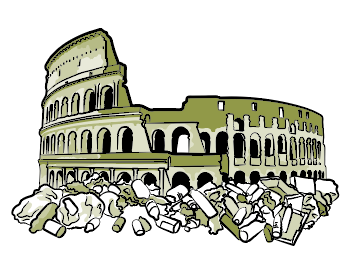Shitting into the past
All ancient cities stand on layers of rubble, waste, and human remains. Rome is no exception. In Sister Stop Breathing, a collection of short fictions centered mostly on the so-called Eternal City, Chiara Barzini weds the seemingly contradictory states of permanence and decay, whether bodily or architectural. “Dead Prime Minister,” for instance, literalizes an undead vibe by introducing a quasi-corpse, “brownish and flaccid,” who retains the ability to “speak and move in small measures.” (Accused of having an affair with a transsexual prostitute and an underage girl, he reasons that “when you’re dead you don’t even know you’re married.”) Former Italian prime minister Silvio Berlusconi’s stink has long lingered in the public consciousness, but Barzini extends it to the city as a whole: surrounded by monuments to the dead, the citizens of present-day Rome are the dead of the future.
“Dead Pope”—separated from “Dead Prime Minister” by a single-page piece called “The Guillotine”—takes place in a “dead city” that both is and is not Rome, following the exploits of a pope whose corpse is paraded around the streets before getting lost and then reappearing under a tree at Villa Pamphili. “Here I am,” he says, which is both a biblical echo and a perfectly natural thing for a dead pope to say.
But knowledge of papal succession, or of the scandals surrounding Italy’s sometime prime minister, or of antiquity in general, is unnecessary for the reader. Sister Stop Breathing has virtually no documentary feel or intent; rather, it takes up the question of how one might create art, or anything at all, while surrounded by artifacts that will outlast everyone who is currently alive, and then some.
Further hints of the stifling force of tradition appear in the guise of the sewage police—“mellifluous, wet people in neoprene uniforms that camouflage themselves as seals from another era,” regulating “the use of ancient pipes in contemporary buildings” against transgressors who “collect raindrops and mix them with urine,” “defecate in bags and throw them out windows,” or even “jump out the window of their smelly bathrooms.” A threat guaranteed to scare Romans, Barzini tells us, is “Your sewage goes into pipes laid in 753 B.C. You are shitting into the past.”
But, she asks, could one do otherwise? Art, shit, and death are the results of linked processes. In Rome especially, new art must not only contend...
You have reached your article limit
Sign up for a digital subscription and continue reading all new issues, plus our entire archives, for just $1.50/month.
Already a subscriber? Sign in





